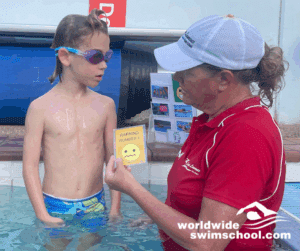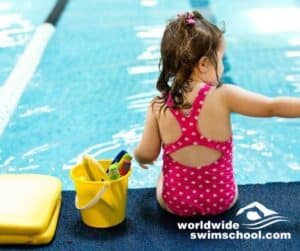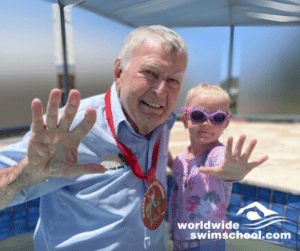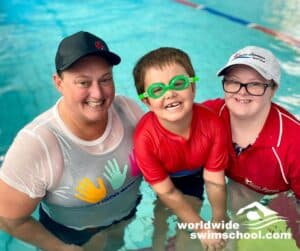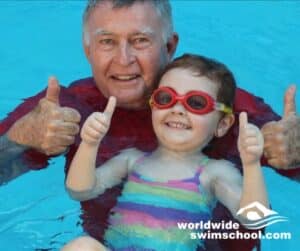Let's take a look at a video of an 8-12 month swim lesson at Laurie Lawrence Swim School. I’d encourage you to show this video to the teachers at your swim school to get ideas and open up a forum for discussion which is relevant to your centre.
Sharing information, opening up lines of communication and brainstorming ideas is fantastic for morale and keeping everyone on the same page. This particular video focuses on the swimming lesson warm up.
Class Background
The 8 -12 month swim class in this video have attended regular weekly swimming lessons with their parents since they were 4 months of age. The parents have a vital role to play in the swimming lesson, because at this very early age, they are the teacher.
For this reason, I believe that the “swimming teachers” role can become that of a water safety educator. They impart knowledge to the parents so that early introductions to the water are conducted in a loving and safe manner.
Social referencing is at its peak during this 8 to 12 month developmental stage. For this reason the more relaxed the parent is with their baby the better they will become in the water. The swimming teacher must encourage parents to:
- Hold their baby softly
- Keep them low in the water so they feel buoyancy
- Smile and enjoy the time together
- Read their baby’s body language
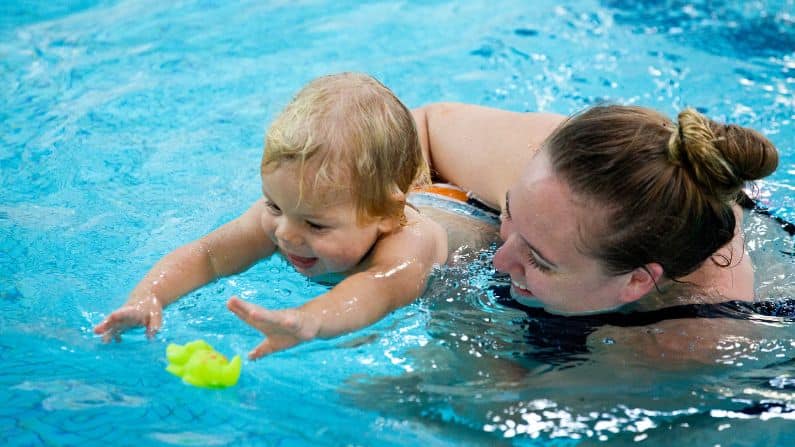
Warm Up
You’ll notice we start the swimming lesson for the 8-12 month swim class with a kicking activity on a shallow teaching ledge. We like to open the swimming lesson in this way because it gives a definite start to the class, allows the teacher to greet all students and allows any late comers time to join the group without interruptions. You can easily duplicate this activity in open water, with the back against a wall, and without a teaching ledge.
Manipulative kicking is important because we are teaching the baby word action association, where they learn what kicking means and how to do it. All manipulative kicking can be followed by an opportunity for independent practice.
During the very early stages the baby’s reflexes will be controlling the kicking action. That is, they will be kicking their legs in response to the stimulation of the water. But as the baby grows with age, this will be replaced with them consciously performing the kicking action.
Conditioning
Conditioning should be included in the warm up of every swimming lesson for children under the age of 2. This prepares baby for the underwater activities like submersions and free floats which happen later in the swimming lesson.
Early attempts at conditioning can be done with a small cup of water. But as the baby becomes proficient, we can extend their breath control by using a bucket.
The swimming teacher must ensure that the parents understand that conditioning is a prerequisite to all underwater work. If children are not responding positively to conditioning, then baby should not be submerged.
Teachers should also encourage parents to incorporate conditioning into the daily bath routine as they will be very helpful for the swimming lesson. Before all submersions parents and teachers should ensure baby is,
- Holding their breath on the verbal trigger words
- Happy and confident with water on the face
- Not resisting in anyway
Upright Seated Kick
Another great activity you can include into the warm up is the upright seated kick. In this instance the parent can easily manipulate the legs as they walk though the water and the baby can clearly see what kicking looks like. As they return to the ledge, the baby is in a prone position for their independent practice. They baby will love the freedom to kick, splash and exercise in this position.
Teachers should encourage parents to hold children high up under the arms to ensure that they align their centre of gravity and don’t get that overbalanced feeling. Remember the baby’s head is quite large in proportion to the rest of their body so if you hold the torso it will not feel as comfortable and balanced.
Review
I hope this video gives you some useful information which you can use as a springboard for discussion within your own swim school. Review and reflection is a vital component in the pursuit of excellence. Our Swim Library will give you more videos to learn about this age group.
Our job as swimming teachers is so important because we are directly influencing the water safety ideas and attitudes of families that we come in contact with. The happiness seen on the parents and children’s faces is the icing on the cake.
Give parents more understanding with our infant video learning packs.
To find out more about what we do, get access to latest offers and releases join our community.

